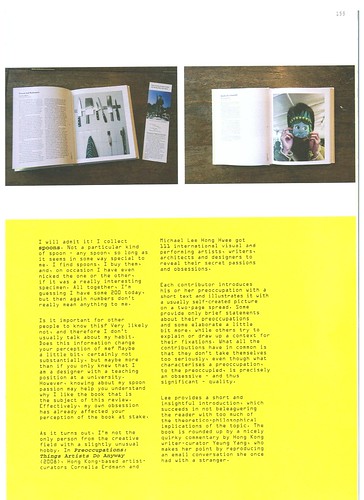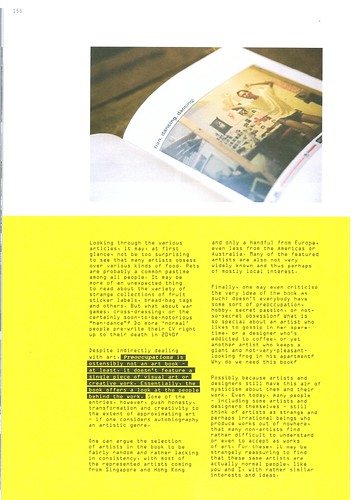Title: Book Review: Preoccupations: Things Artists Do Anyway
Author: Peter Benz
Photo: han yesterday was great
Media: Singapore Architect 245
Date: Aug 2008 issue
City: Singapore




I admit it: I collect spoons. No particular spoons, just any spoon as long as it is somewhat special to me. I buy spoons, I find them, at occasions I have even nicked the one or the other, if it was a really interesting specimen. All together I guess I have about 200 of them today, but then again numbers don’t really matter to me.
Is it important for other people to know this? Very likely not and therefore usually I don’t talk about my habit. Does this information change your perception of me? Maybe a little bit, certainly not substantially, but maybe more than if you only knew that I am a designer with a teaching-position at a university. However: knowing about my spoon-passion may let you understand why I like the book that is the object of this review. So, effectively my obsession has already affected your perception of the book at stake.
As it turns out, I’m not the only person from the creative field who has a slightly unusual preoccupation. In Preoccupations: Things Artists Do Anyway the Hong Kong-based artists/curators Cornelia Erdmann and Michael Lee Hong-Hwee have 111 international visual artists, performing artists, writers, architects and designers reveal their secret obsessions and passions.
On one double-spread each contributor introduces his/her preoccupation in a short text and illustrates it with a (usually) self-created picture. Some of the contributors provide only brief statements about their preoccupations, some will elaborate a bit more, some try to explain or put into context. All of the contributions have in common that they don’t take themselves too seriously, even though it is the nature of a preoccupation that to the preoccupied it is rather obsessive, thus important.
Lee provides a short and insightful introduction, without overdoing the theoretical/philosophical aspect that the topic could also imply. The book is rounded by a nicely quirky commentary by Hong Kong’s writer/curator Yeung Yang who makes her point by reproducing an email-conversation she had with a stranger.
Scanning through the various articles, it may at first glance not be very surprising to see how many artists obsess about various kinds of food. Also pets are probably a common pastime among all people. It may be more un-expected to read about a variety of strange collections: fruit-labels, tags of bread-bags and others. But how about war-games, cross-dressing or the certainly soon-to-be notorious “han-dance”? Do “normal” people pre-write their CV up until their death in 2040?
Despite indirectly dealing with art Preoccupations is not at all an art-book – at least it doesn’t feature a single piece of visual art. Essentially Preoccupations only offers a (humorous) look at the people behind the work. However, some of the entries push honesty, transformation and creativity so far that they approximate 'art' – if one considers autobiography as an artistic genre.
One may argue the selection of artists in the book is fairly random and probably that feeling is correct: there is a lack of consistency with most of the represented artists coming from Singapore and Hong Kong and only a handful from Europe, even less from the Americas or Australia. Also many of the featured artists are not very widely known and thus probably of mostly local interest.
Finally, one may even criticise the very idea of the book as such: doesn’t everybody have some sort of preoccupation, a hobby, as secret passion, a not-so-secret obsession? What is special about an artist who likes to gossip in her spare-time? Or a designer who is addicted to coffee? Or yet another artist who keeps a giant, not very pleasant looking frog in his apartment? Why do we need this book?
Possibly because artists and designers do have this air of mysticism about them and their work. Even today, many people – including some artists/designer themselves – still think of artists as strange, maybe irrational beings, who out of nowhere produce works, that many non-artists find rather difficult to understand or even to accept as works of art. For those it may be strangely re-assuring to find that these same artists are actually normal people, like you and I, with similar interests and ideas.
However, the strength of Preoccupations lies not in the mere collection of a variety of unusual hobbies and pastimes. Many of the contributors relate their preoccupations with their work and thereby reveal their way of thinking. In a very casual way the reader can learn what matters to the artist and how he/she tries to express him-/herself in a non-art situation. Thereby the artistic process in general is at least partly de-mystified and brought back into an everyday-context, maybe similar to the way I chose to begin this article.
In this way Preoccupations is a bit like reading between the lines of visual art: it doesn’t provide information that is strictly needed to understand the idea or nature of contemporary art. But you feel so much better if you do get that additional point.
Then again, having said this: after the artists disclose themselves through their preoccupations, there comes the moment when the reader may get to the point of thinking: If they are just like me, where does the art then come from? Why am I not an artist? Or am I?
Preoccupations at no point aims to give the answer. More ambitious books have failed to do so before. Beautifully layouted, kept predominately in white and yellow colour, Preoccupations gracefully rests within itself, a faint smile upon its pages.
__
Preoccupations: Things Artists Do Anyway was first launched on 19 Jul 2008 at Kubrick Bookshop Café, Hong Kong, in-conjunction with the Hong Kong Book Fair 2008. It will be relaunched with a reading session by selected contributors on 13 Sep 2008, 3-5pm, at Food #03 at Post-Museum, 109 Rowell Road, Singapore 208033, as a parallel event of the 2nd Singapore Biennale 2008. It is available for purchase at leading bookshops, including Kubrick Bookshop, Kapok (both in Hong Kong), Post-Museum and Books Actually (both in Singapore).
No comments:
Post a Comment